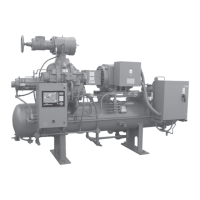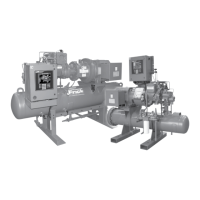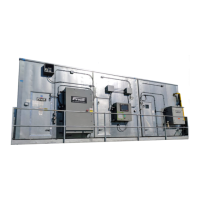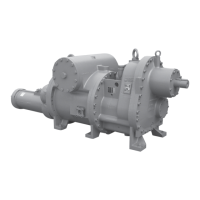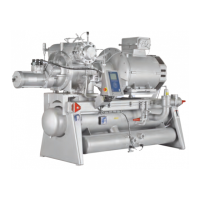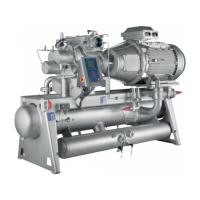RWF II ROTARY SCREW COMPRESSOR UNITS
MAINTENANCE
070.610-IOM (JUN 11)
Page 24
Maintenance
GENERAL INFORMATION
This section provides instructions for normal main tenance,
a recommended maintenance program, troubleshooting and
correction guides, and typical P and I diagrams. For typical
wiring diagrams and information about the Quantum
™
LX
control panel, consult publication 090020 M.
THIS SECTION MUST BE READ
AND UN DER STOOD BEFORE AT-
TEMPTING TO PERFORM ANY
MAIN TENANCE OR SERVICE TO THE UNIT.
NORMAL MAINTENANCE OPERATIONS
When performing maintenance you must take several
precau tions to ensure your safety:
1. IF UNIT IS RUNNING, PRESS [STOP] KEY.
2. DISCONNECT POWER FROM UNIT BEFORE PERFORM-
ING ANY MAINTENANCE.
3. WEAR PROPER SAFETY EQUIPMENT WHEN COMPRES-
SOR UNIT IS OPENED TO ATMOSPHERE.
4. ENSURE ADEQUATE VENTILATION.
5. TAKE NECESSARY SAFETY PRECAUTIONS REQUIRED
FOR THE REFRIGERANT BEING USED.
CLOSE ALL COMPRESOR PACKAGE
ISOLATION VALVES PRIOR TO SER-
VICING THE UNIT. FAILURE TO
DO SO MAY RESULT IN SERIOUS INJURY.
GENERAL MAINTENANCE
Proper maintenance is important in order to assure long and
troublefree service from your screw compressor unit. Some
areas critical to good compressor operation are:
1. Keep refrigerant and oil clean and dry, avoid moisture
contamination. After servicing any portion of the refrigera
tion system, evacuate to remove moisture before returning
to service. Water vapor condensing in the compressor while
running, or more likely while shut down, can cause rusting
of critical components and reduce life.
2. Keep suction strainer clean. Check periodically, par
ticularly on new systems where welding slag or pipe scale
could nd its way to the compressor suction. Excessive dirt
in the suction strainer could cause it to collapse, dumping
particles into the compressor.
3. Keep oil lters clean. If lters show increasing pressure
drop, indicating dirt or water, stop the compressor and
change lters. Running a compressor for long periods with
high lter pressure drop can starve the compressor for oil
and lead to premature bearing failure.
4. Avoid slugging compressor with liquid refrigerant. While
screw compressors are probably the most tolerant to in
gestion of some refrigerant liquid of any compressor type
available today, they are not liquid pumps. Make certain to
maintain adequate superheat and properly size suction accu
mulators to avoid dumping liquid refrigerant into compressor
suction.
Keep liquid injection valves properly adjusted and in good
condition to avoid ooding compressor with liquid. Liquid can
cause a reduction in compressor life and in extreme cases
can cause complete failure.
5. Protect the compressor during long periods of shut down.
If the compressor will be sitting for long periods without run
ning it is advisable to evacuate to low pressure and charge
with dry nitrogen or oil. This is particularly true on systems
known to contain water vapor.
6. Preventive maintenance inspection is recommended any
time a compressor exhibits a noticeable change in vibra tion
level, noise or performance.
COMPRESSOR SHUTDOWN and START-UP
For seasonal or prolonged shutdowns the following procedure
should be followed:
1. Reduce the system pressure to the desired condition.
2. Press [STOP] key to cease operation of the compressor.
3. Open disconnect switches for compressor motor and oil
pump starters.
4. Turn on oil heater circuit breaker.
5. Close suction and discharge service valves, also liquid
injection and economizer service valves, if applicable.
Attach CLOSED TAGS.
6. Shut off cooling water supply valve to oil cooler, if ap
plicable. Attach CLOSED TAG.
7. Protect oil cooler from ambient temperatures below
freezing or remove water heads.
To start up after a seasonal or prolonged shutdown the fol
lowing procedure should be followed:
1. Any water necessary for the operation of the system that
may have been drained or shut off should be restored and
turned on.
2. Open suction and discharge service valves, also liquid in
jection and economizer service valves, if applicable. Remove
tags.
3. Close disconnect switches for compressor, motor and oil
pump starters.
4. Turn off oil heater circuit breaker.
5. Perform checkpoints on prestart check list, then start unit.
GENERAL INSTRUCTIONS FOR REPLACING
COMPRESSOR UNIT COMPONENTS
NOTE: See Publication 070-660 SM for procedures cover-
ing replacement motor and compressor mounting.
When replacing or repairing components which are exposed
to refrigerant pressure (including suction strainer) proceed
as follows:
1. Push [STOP] key on control panel to shut down unit.
2. Open disconnect switches for compressor and pump
motor starters.
3. Close suction and discharge service valves, also liquid
injection and economizer service valves, if applicable.
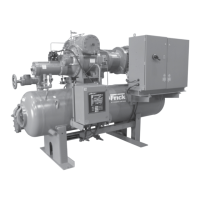
